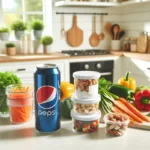How To Know If Food Contains E Numbers?
Category: Generic Scanners
Focus Keyword: how to know if food contains e numbers?
Understanding E Numbers: What Are They and Why Should You Care?
Whether you’re shopping for groceries, managing food sensitivities, or simply aiming for a healthier diet, knowing what’s in your food is essential. One group of ingredients that often raises questions is E numbers—codes assigned to food additives approved for use in the European Union and recognized globally. But how to know if food contains E numbers? This guide will walk you through everything you need to know, from reading labels to using smart scanning apps like Food Scan Genius.
What Are E Numbers?
E numbers are codes for substances used as food additives, such as preservatives, colorings, flavor enhancers, and emulsifiers. Each E number corresponds to a specific additive, for example:
- E100 – Curcumin (coloring)
- E200 – Sorbic acid (preservative)
- E621 – Monosodium glutamate (flavor enhancer)
These codes help standardize ingredient listings across countries, making it easier to identify additives regardless of language. According to the European Food Safety Authority (EFSA), E numbers are rigorously evaluated for safety before approval.[1]
Why Should You Check for E Numbers in Food?
Some people are sensitive to certain additives, while others prefer to avoid them for health or dietary reasons. Recent news from The New York Times highlights growing consumer awareness about food additives and the differences in regulations between the US and Europe.[2]
- Food allergies and sensitivities: Some E numbers may trigger reactions.
- Dietary preferences: Vegetarians, vegans, and those following religious diets may need to avoid certain additives.
- Health concerns: Ongoing research, such as studies published in PubMed, investigates potential links between additives and health.[3]
How to Know If Food Contains E Numbers: Step-by-Step Guide
Finding out if your food contains E numbers is easier than you might think. Here’s how to do it:
-
Read the Ingredient List
- Look for codes starting with “E” followed by three or four digits (e.g., E330, E202).
- Sometimes, the additive name is listed instead of the code (e.g., “citric acid” instead of “E330”).
-
Check for Additive Names
- Manufacturers may use either the E number or the chemical name. Familiarize yourself with common additives.
-
Use a Food Scanner App
- Apps like Food Scan Genius instantly analyze product barcodes and ingredient lists, flagging E numbers and providing detailed information.
- Consult Official Lists
Labeling Laws: US vs. EU and Beyond
| Region | Labeling Requirement | Authority |
|---|---|---|
| United States | Names of additives listed; E numbers rarely used | FDA |
| European Union | E numbers or additive names must be listed | EFSA |
| Australia/New Zealand | E numbers or additive names listed | FSANZ |
In the US, food labels typically list the chemical name of the additive (e.g., “ascorbic acid” instead of “E300”). In the EU, products must display either the E number or the additive name. This difference can make it harder to spot E numbers in American products, but easier in Europe.[5]
Recent coverage from BBC News discusses how stricter European regulations are influencing global standards.[6]
Common E Numbers in Everyday Foods
| E Number | Name | Function | Typical Foods |
|---|---|---|---|
| E100 | Curcumin | Coloring | Curry, Mustard |
| E200 | Sorbic Acid | Preservative | Cheese, Baked Goods |
| E300 | Ascorbic Acid | Antioxidant | Juices, Jams |
| E621 | Monosodium Glutamate | Flavor Enhancer | Soups, Snacks |
How Food Scan Genius Makes Identifying E Numbers Effortless
Manually checking every label can be time-consuming, especially if you have dietary restrictions or food sensitivities. Food Scan Genius streamlines this process:
- Instant scanning: Use your phone to scan barcodes or ingredient lists.
- Detailed breakdown: See which E numbers are present and what they mean.
- Personalized alerts: Get warnings for additives you want to avoid.
- Global database: Works with products from the US, EU, and beyond.
“I have a sensitivity to certain food additives, and Food Scan Genius has been a lifesaver. Now I can shop with confidence, knowing exactly what’s in my food. Highly recommend downloading it!” – Maria S., Berlin
Download Food Scan Genius to make smarter, safer food choices today.
Q&A: Frequently Asked Questions About E Numbers
Q1: Are E numbers safe to consume?
Most E numbers are approved by regulatory bodies like the FDA and EFSA after thorough safety assessments. However, some individuals may have allergies or sensitivities to specific additives. Always check labels and consult healthcare professionals if you have concerns.[1]
Q2: How can I avoid E numbers in my diet?
Choose whole, unprocessed foods and read ingredient lists carefully. Use apps like Food Scan Genius to flag products containing E numbers and receive personalized recommendations.
Q3: Why do some countries use E numbers and others don’t?
The use of E numbers is most common in Europe and regions following EU standards. In the US, additives are listed by name. This difference affects how easily you can spot additives when shopping internationally.[5]
Q4: Can E numbers affect children or people with health conditions?
Some studies suggest certain additives may impact sensitive groups, such as children with ADHD or individuals with allergies.[3] Always consult your doctor and use tools like Food Scan Genius for added safety.
Conclusion: Empower Your Food Choices
Understanding how to know if food contains E numbers is a crucial step toward making informed, healthy decisions. By reading ingredient lists, staying aware of global labeling laws, and leveraging smart technology like Food Scan Genius, you can take control of your diet—no matter where you shop. Stay informed, scan smart, and enjoy peace of mind with every bite.





